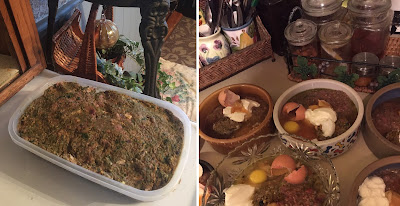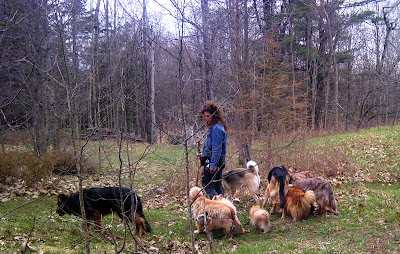IS YOUR DOG HUNGRY OR LOOKING FOR ATTENTION
If your dog is always hanging about you looking for food, whining for food, begging for food you might wonder is my dog really that hungry? Should I be concerned?
Well to figure out if your dog is truly hungry or just using food to get attention take a look at your dog…if they look to be a good weight - not to thin (no bones protruding, etc.) and not to heavy (they have a nice waist line) then you know that the demands are just that - demands. Check the chart below to assess your dog’s weight.
IF YOUR DOG IS OVERWEIGHT
Being overweight is as bad for a dog as it is for a human. Dogs can have joint problems, diabetes, heart problems and so on just as humans do from carrying excess weight. Just as obesity can seriously shorten a human’s life - it can also shorten a dog’s life. A dog that is overweight certainly lives a lesser quality of life!
Once again we have to be fair to the dog first and foremost - if you are feeding your dog highly processed pet food (e.g. kibble, cold pressed food, wet food, canned food) your dog's food is packed with starchy carbohydrates that cause and contribute to blood sugar issues, other metabolic issues, gastrointestinal issues and many other health issues and conditions. Learn more about that in this article.
Its important to feed your dog a species appropriate raw diet or fresh and gently cooked diet.
There are several things you should do. First make sure that there is no medical reason for the excess weight, such as a thyroid issue - your veterinarian can do a simple blood test to ensure weight gain is not due to any medical issue.
If you are certain that your dog’s health is good, then you really need to take a look at your dog’s daily regimen…
A - Does your dog get enough exercise on a daily basis? When it comes to exercise, all dogs need exercise - small breed, medium and large breed dogs. For some dogs a daily brisk 30 minute walk might be OK, while other dogs may require two 40 minute to 60 minute walks a day…just like people, every dog is different.
B - Do you feed your dog too much food? Do you feed your dog the wrong foods?
And you really need to take a look at your habits - sorry, but this is often the root of the problem with your dog's weight. I can't help you and your dog if I do not push you to see how we affect our dogs!
C - Many people use food to show affection and love to their dogs...this can lead to significant weight gain, deterioration of health and quality of life as well as behavioral problems;
D - Many people also use treats as their primary or even sole method of 'training' their dog - I do not recommend this!
There are several things you should do. First make sure that there is no medical reason for the excess weight, such as a thyroid issue - your veterinarian can do a simple blood test to ensure weight gain is not due to any medical issue.
If you are certain that your dog’s health is good, then you really need to take a look at your dog’s daily regimen…
A - Does your dog get enough exercise on a daily basis? When it comes to exercise, all dogs need exercise - small breed, medium and large breed dogs. For some dogs a daily brisk 30 minute walk might be OK, while other dogs may require two 40 minute to 60 minute walks a day…just like people, every dog is different.
B - Do you feed your dog too much food? Do you feed your dog the wrong foods?
C - Many people use food to show affection and love to their dogs...this can lead to significant weight gain, deterioration of health and quality of life as well as behavioral problems;
D - Many people also use treats as their primary or even sole method of 'training' their dog - I do not recommend this!
First of all dogs do not use treats as their primary method of instructing each other, they use body language and state-of-being as a primary teaching tool - we should too.
Using treats only - the human never learns to be aware of the more effective, more natural ways in which to communicate with and coach/mentor our dogs - this is a great opportunity lost. When we learn to use other means more natural to a dog we open up a whole new world of awareness and connectivity in ourselves - we enable the best in ourselves and our dogs. I recommend that you read these articles to learn more...
Take A Breath, Breath - Dogs Understand Breathing is Communication
Leadership
About 50% of Dogs in North America are overweight. When my client’s dogs are overweight I usually ask them a serious of questions and then provide them with information and advice on how to regain control of their dog’s weight.
One of the most common issues I see is that people leave food in their dog’s bowl 24/7. This is even more of an issue if you have multiple dogs - as some dogs have a built in sensor that tells them when to stop eating, other dogs will keep eating until there is nothing left to eat. Much like people!
Dogs are not grazers like rabbits, horses and cows. Dogs are hunters and are biologically evolved to eat their meal and then fast until the next meal. When we leave food out for them on a constant basis we create an unnatural condition. It is far better to feed your dog twice or three times a day. If your dog does not eat all of the food in their bowl within a matter of minutes lift the bowl up and offer a little less food next time.
To reduce your dog’s weight - don’t do anything drastic, just cut back their regular portions by a small amount and allow your dog to lose weight slowly. Once your dog has lost the desired amount of weight you can increase the food a tiny bit and maintain from there.
IF YOUR DOG IS UNDERWEIGHT
Again, make sure that there is no medical condition at the root of your dog’s inability to gain weight.
Leadership
About 50% of Dogs in North America are overweight. When my client’s dogs are overweight I usually ask them a serious of questions and then provide them with information and advice on how to regain control of their dog’s weight.
One of the most common issues I see is that people leave food in their dog’s bowl 24/7. This is even more of an issue if you have multiple dogs - as some dogs have a built in sensor that tells them when to stop eating, other dogs will keep eating until there is nothing left to eat. Much like people!
Dogs are not grazers like rabbits, horses and cows. Dogs are hunters and are biologically evolved to eat their meal and then fast until the next meal. When we leave food out for them on a constant basis we create an unnatural condition. It is far better to feed your dog twice or three times a day. If your dog does not eat all of the food in their bowl within a matter of minutes lift the bowl up and offer a little less food next time.
To reduce your dog’s weight - don’t do anything drastic, just cut back their regular portions by a small amount and allow your dog to lose weight slowly. Once your dog has lost the desired amount of weight you can increase the food a tiny bit and maintain from there.
IF YOUR DOG IS UNDERWEIGHT
Again, make sure that there is no medical condition at the root of your dog’s inability to gain weight.
Also make sure that your dog is not suffering from an infestation of parasites such as round worm. When my Boxer Robbie arrived at 8 months old his back at the waist was about 7cm / 3 inches across - he was infested with round worms! Once you are sure there is no medical reason and no infestation then you know your dog requires either more food or better quality food.
Just like people, some dogs have a faster metabolism than other dogs and require more food to maintain a healthy weight. You need to increase your dog’s intake of nutrient rich food stuffs - just make sure that you don’t over do it overtime. When you see your dog has gained enough weight make sure that you do not start to overfeed - you want to maintain a good weight!
Just like people, some dogs have a faster metabolism than other dogs and require more food to maintain a healthy weight. You need to increase your dog’s intake of nutrient rich food stuffs - just make sure that you don’t over do it overtime. When you see your dog has gained enough weight make sure that you do not start to overfeed - you want to maintain a good weight!
UNDERSTAND WHAT GOOD NUTRITION CONSISTS OF
Highly processed pet food diet, dog kibble, causes metabolic issues in dogs. Learn more in this article.
Highly processed pet food diet, dog kibble, causes metabolic issues in dogs. Learn more in this article.
Transition your dog to a species appropriate raw or gently cooked and fresh food diet.
OK, so now we need to fix the whining and begging for food issue…
SO YOUR DOG WHINES OR BARKS AT YOU WHEN IT WANTS FOOD...
Did you teach it to do this as a little trick? Did your dog just start this own its own? Or perhaps the dog is a rescue and this is a behaviour that the dog already had. Or maybe your dog is a rescue and has been traumatized in the past by not receiving food on a regular basis.
No matter what the reason, you might find this behaviour to be kind of cute and endearing at first. But, unless you have also taught your dog the threshold - the limit, when to stop…this behaviour can be:
A - Habit forming;
B - May escalate to dominating, reactivity, anxious, neurotic behaviour;
If this happens, it can really get you irritated, which will make the dog more anxious = psychological damage to your dog and to you.
Yeap, not so good and definitely not cute any more!
SO WHAT SHOULD YOU DO TO STOP THE BEHAVIOUR?
FIRST LET’S TALK ABOUT THE PSYCHOLOGICAL SIDE OF THINGS.
When your dog demands attention and rewards (whether food, affection, toys, etc.) your dog is taking control of the situation - this is not good, as you have just surrendered control of the situation to your dog and in so doing have lost some of his respect for you as a leader. Please take note this is not the same as when your dog looks at you for direction…in this case your dog is not asking he is telling!
If your dog is a rescue, underweight or overweight and you feel sorry for him, you are adding and abetting this bad habit. Stop feeling bad for your dog - this undermines his self confidence and can make him anxious and if your lack of leadership continues your dog can become aggressive reactive…pushiness can grow exponentially.
If you are starting to feel annoyed or frustrated with your dog, you are only going to increase his will to bark. Your lack of control of your emotions reinforces his understanding that you are not in control of the situation. More reason for him to take over! If you yell at your dog to stop barking - you are barking too, and that is leading by the wrong example.
Please do not say to your dog ‘would you just stop that!’ or I wish you would stop doing that’, or ‘you are bothering me, quite it!’ If you do this you are not providing direction, nor are you embracing the role of leader. You are whining and complaining not providing direction! When we whine instead of direct, we give our dog a choice - you can listen to me or not. Just like humans, most will choose the ‘not’ option.
Before you read any further - read these two articles if you have not already. They will only take you a few minutes to read - but will really improve your understanding of how dogs assign respect to their humans and how our state of being can either work for us or against us in our endeavour to direct our dogs.
How Dogs Assign Respect to Humans
The Sensitivity of Dogs
SO WHAT SHOULD YOU DO?
Train yourself, coach and mentor your dog. If you ask the right way your dog will listen - he does not need to be trained…but you do! Get your emotional state under control, engage your working mode on and let’s go.
Before you attempt to direct your dog…set your expectations…
First - remember that your dog has been doing this for awhile - I have the experience to make change immediate, you probably do not so be patient. Be calm, be deliberately confident, be assertive but fair, and have the expectation in your mind that your dog will listen. You need to be consistent, persistent and100% committed to the direction you provide (your dog knows when your are not!). Your will must be stronger than your dogs.
Be prepared to give a full instruction. A full instruction consists of:
1 - Getting your dogs attention;
2 - Telling him what you do not what him to do;
3 - Telling him what you do want him to do instead, and;
4 - Following through to correct him if he backslides into the unwanted behaviour.
The leadership role is one of coaching and mentoring with fair, firm, clear direction. Never match your dog’s state but you do have to match the intensity of his behaviour. I see a lot of people doing only step 2. Then the poor dog gets in trouble as it goes back to doing the unwanted behaviour as its human has not provided a full set of instructions! Blame yourself, not your dog!
Firstly, if you dog barks you have to disagree right away. If you wait and then address your dog he will not understand what you are disagreeing with. To disagree with the bark you can:
A - Say ‘shh’ or ‘no’;
B - Snap your fingers;
C - Or give your dog a ‘nip’ (take your fingers and form a claw like shape, quickly tap your fingers once against your dog’s waist or neck and say ‘no’ or ‘shh’
Remember that the energy behind the direction is everything. Your emotions must be disengaged, you must be calm, assertive-confident, never angry, frustrated etc.
2 - Telling him what you do not what him to do;
3 - Telling him what you do want him to do instead, and;
4 - Following through to correct him if he backslides into the unwanted behaviour.
The leadership role is one of coaching and mentoring with fair, firm, clear direction. Never match your dog’s state but you do have to match the intensity of his behaviour. I see a lot of people doing only step 2. Then the poor dog gets in trouble as it goes back to doing the unwanted behaviour as its human has not provided a full set of instructions! Blame yourself, not your dog!
Firstly, if you dog barks you have to disagree right away. If you wait and then address your dog he will not understand what you are disagreeing with. To disagree with the bark you can:
A - Say ‘shh’ or ‘no’;
B - Snap your fingers;
C - Or give your dog a ‘nip’ (take your fingers and form a claw like shape, quickly tap your fingers once against your dog’s waist or neck and say ‘no’ or ‘shh’
Remember that the energy behind the direction is everything. Your emotions must be disengaged, you must be calm, assertive-confident, never angry, frustrated etc.
Secondly, your dog should not be in your food prep space. When your dog learns to sit and relax quietly you can relax the rule, but for know he needs to exit stage left! The approach you take to communicate to your dog should depend on the sensitivity level of your dog. Some dogs see touch as an engagement to converse, be excited. Other dogs see voice as engagement. Engagement gives the dog the opportunity to argue and debate the situation with you - that is not what you want. You want to disengage and direct.
If your dog is very sensitive pointing your finger and calmly saying ‘out’ may be enough. If your dog is less sensitive and fully committed to perusing his course of action you need to intensify your direction to him.
The best method is to simply use your body to herd your dog out of the space and then show him where you want him to sit/lie down. This is using dog language rather than human language - a very clear and effective way to communicate. If your dog gets up simply herd him back to the desired location. It is better not to talk, touch or look - just herd.
If your dog begs for food, you can use the same technique to discourage the begging.
Remember that when we develop a habit it takes time, effort and commitment to get rid of the habit...affecting change may take hours, days, weeks or more. So to with dogs.
Further, your strength as a leader and effective communicator will determine how quickly the behaviour can be turned around. I can affect change immediately because I have trained myself to be aware, I use instinct and intuition and have a lot of experience working with dogs in all states of being. You will have to be patient and fair with yourself and your dog to achieve success as your experience is less comprehensive. Not to worry, just boost your commitment to achieving your goal and you will move along at a good pace.
Holistic Diet, Nutrition, Wellness Services Tailored to Your Individual Dog and Cat
For information about my holistic diet, nutrition and wellness services, visit my holistic wellness services page.
Maintain good health | Address acute and chronic health issues | Pre and post surgery support and recovery
My holistic wellness services are available worldwide via video consultation.
🌎 USA | Canada | UK | Europe | Australia | New Zealand | Asia | South and Central America | Africa | UAE
📱FaceTime | Facebook | Skype | WhatsApp
To set-up your holistic wellness consultation get in-touch via email, go to my contact me page.
Holistic Behavioral Services for Your Dog
For information about my holistic behavioral services, visit my holistic behavioral services page.
For dogs of all ages, sizes and breeds.
My behavioral services are available worldwide via video consultation.
🌎 USA | Canada | UK | Europe | Australia | New Zealand | Asia | South and Central America | Africa | UAE
📱FaceTime | Facebook | Skype | WhatsApp
To set-up your holistic behavioral session get in-touch via email, go to my contact me page.
Affiliations to Companies
✓ None.
✓ I don't sell food, supplements, or other products.
✓ I'm not aligned with any companies.
Article and graphics by Karen Rosenfeld.










